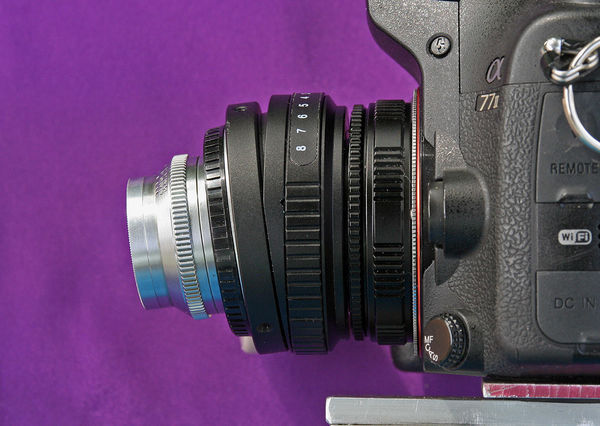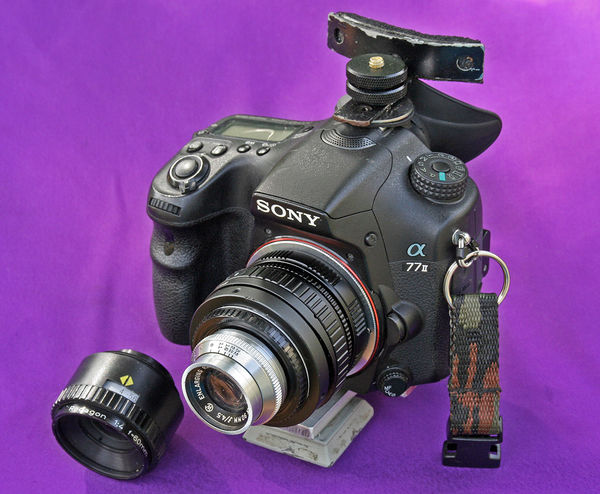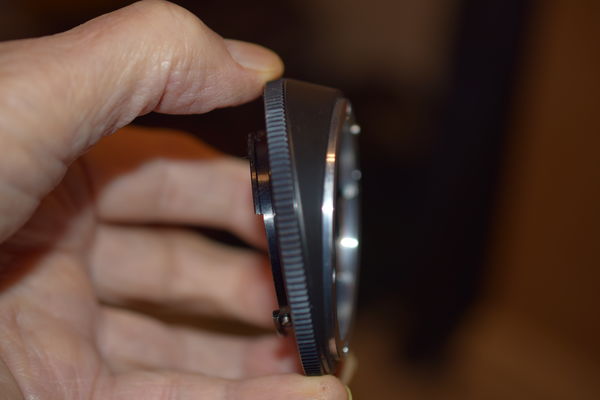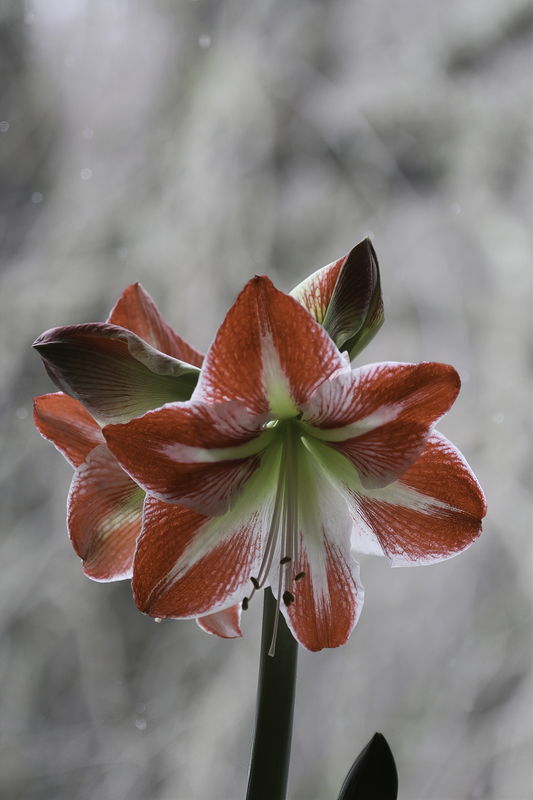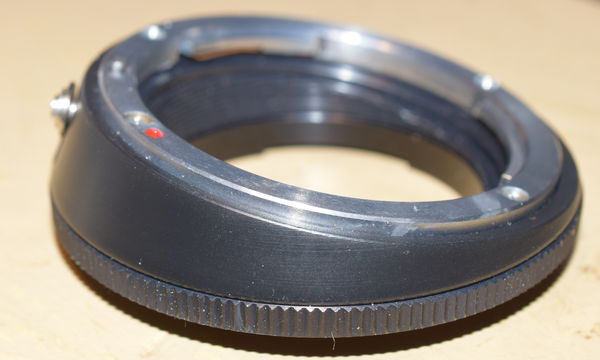Shooting macro pics of flowers.
Jan 8, 2020 17:44:18 #
bleirer wrote:
Check out reviews for your lens, for example here ... (show quote)
Very interesting information. Similar to the results my little test came up with. Canon's test was much more thorough.
Jan 8, 2020 18:02:04 #
imagemeister wrote:
The only thing I will say is by using a TILTING macro lens - like the ones Canon makes, you can control the plane of focus - somewhat - which combined with aperture and focal length and sensor size/cropping - might get you to where you want to be . I am CHEAP - so I made my own tilting macro lens.
.
.
That would be worth seeing. Is it a secret?
Jan 8, 2020 18:16:13 #
BocaMac wrote:
That would be worth seeing. Is it a secret?
https://www.bhphotovideo.com/c/product/1354805-REG/canon_ts_e_90mm_f_2_8l_tilt_shift.html
But, this is mine ...tilt only. Shown here with 90mm 4.5 Raptar enlarging lens. Because this is basicly a mirror less camera, I can see focus peaking and a well illuminated subject even when stopped down because of the EVF........
.
Jan 8, 2020 20:43:03 #
rborud
Loc: Minnesota
BocaMac wrote:
There is a puzzle that I can't crack. Is there an... (show quote)
Hi BocaMac I do do a good bit of Macro and close up photography, a method no one has mentioned to do what you are trying to is using shift/tilt lenses on you camera. Do not faint I do not suggest buying one of these, they do do bodily injury to ones checkbook or credit card. I use a small adapter sometimes in the situation you describe you are in. I am including a pix. One works only in manual and close. The good thing it lengthens the depth of field a good bit. Mine is Nikon but I do believe mount is in several mounts.
I must say it does take a bit of practise but I have had quite good luck with it. I found the source in ebay.
And paid around $70.00 for it. It also twists to both horizontal and vertical. You might consider it.. RBorud
Jan 8, 2020 21:33:25 #
CHG_CANON wrote:
You might find a Depth of Field Calculator to be u... (show quote)
And using Topaz Sharpen AI in Focus Mode, one can actually expand the Depth of Focus slightly. The flower attached here has had its depth increased slightly. If I had RAW to work with, the results would have been even better. I used the flower posted by boberic as an example here. The depth of field is a bit deeper. But not completely all in focus.
But stacking would be even better. And some cameras can even stack in camera.
Jan 8, 2020 22:13:42 #
[quote=Blenheim Orange]If you are not going to focus bracket and stack, then the task becomes creatively using the limited depth of field to best effect. ISO and shutter speed are not the issue. These shots were all done with a Canon 100mm macro lens. The aperture is f/16. Smaller than that introduces more diffraction than I like. Diffraction is a softening of the image that happens with smaller apertures. Shutter speed 1/100th, ISO 100.
These are very small blossoms on delicate plants, close to the ground, out in the field, which makes photographing them a challenge. I use diffused off-camera flash and various reflectors and diffusers. Careful composition and control over lighting are the keys. I rarely vary ISO, shutter speed or aperture, instead I focus on lighting and composition.
These photos are not true macros (1:1 or greater magnification), but many techniques that are used for macro photography are useful for this sort of photograph. Check out the True Macro section here, and especially the thread about macro equipment set-ups.
Feel free to ask questions, by private message if you prefer.
Mike
Those are REALLY nice flower close-ups. Love the lighting.
These are very small blossoms on delicate plants, close to the ground, out in the field, which makes photographing them a challenge. I use diffused off-camera flash and various reflectors and diffusers. Careful composition and control over lighting are the keys. I rarely vary ISO, shutter speed or aperture, instead I focus on lighting and composition.
These photos are not true macros (1:1 or greater magnification), but many techniques that are used for macro photography are useful for this sort of photograph. Check out the True Macro section here, and especially the thread about macro equipment set-ups.
Feel free to ask questions, by private message if you prefer.
Mike
Those are REALLY nice flower close-ups. Love the lighting.
Jan 8, 2020 22:19:04 #
BocaMac wrote:
There is a puzzle that I can't crack. Is there an... (show quote)
Why the aversion to focus stacking?
Jan 8, 2020 23:01:04 #
smussler
Loc: Land O Lakes, FL - Formerly Miller Place, NY
BocaMac wrote:
That is really some set up. the pictures are really striking. Not sure the rocking technique would work for me. Not always steady on my feet. Not sure what all would be included in my pictures that I did not want. But if a person can and does do it, they have a gift that I don't have. You are a lucky person. Your rail is the way I am headed as soon as I decide on the software.
I tried focus stacking for a bit when I first got my camera - with flowers. Check out Picolay. It's free software for photo stacking. I got better results with it than I got with a purchased product, which was putting artifacts in the final stacked image. Only tried photo-stacking for a few days, just to experiment with it. The images that the experts are posting here are breath taking. The software that they are using is probably heads and shoulders above Picolay, but I liked the price. I googled Free Photo Stacking software and came across a URL that listed a number of products with reviews. I intentionally didn't name the commercial product, as the artifacts that I was getting may very well have been due to my inexperience with PP photo stacking software (Actually no experience) - and the cheap tripod that I had at the time.
I was using a 40mm Macro, but was not using it at a true 1:1 macro distance. I was trying to not move the camera, but took 9 pics, refocusing manually on different flowers in a vase. www.picolay.de My first attempt:
Jan 8, 2020 23:47:08 #
lamiaceae wrote:
Those are REALLY nice flower close-ups. Love the lighting.
Thanks.
Jan 8, 2020 23:54:42 #
rborud
Loc: Minnesota
BocaMac wrote:
There is a puzzle that I can't crack. Is there an... (show quote)
Hi BocaMac I sent you the information about the shift adaptor. I looked and I realized I added the wrong pix, so here is the right one, sorry. Rborud
Jan 9, 2020 05:45:10 #
Jan 9, 2020 09:38:12 #
Norm W.
Loc: Southern CA
Mirror lock up is another step to help reduce vibration in the camera which will improve sharpness of the image.
Jan 9, 2020 11:38:45 #
Norm W. wrote:
Mirror lock up is another step to help reduce vibration in the camera which will improve sharpness of the image.
Or, by not having a mirror ....
Jan 9, 2020 12:18:15 #
amfoto1
Loc: San Jose, Calif. USA
BocaMac wrote:
There is a puzzle that I can't crack. Is there an... (show quote)
If you have a Canon 100mm Macro lens, you already have one of the very best available. No need to buy a new lens, so long as the magnification you're getting is sufficient (with or without extension tubes).
100mm Macro maximum magnification........ 1:1 (life size)
100mm + 25mm extension tube max mag... 1.35:1
100mm + 50mm extension tube max mag... 1.73:1
100mm + 62mm extension tube max mag... 1.90:1
Note: Above was the result with Canon's own 25mm (two) and 12mm extension tubes. Other tubes come in different sizes and will render different magnification. For example, the Kenko set includes 12mm, 20mm and 36mm tubes. Those can be combined in various ways to give 32mm, 48mm, 56mm and 68mm of extension. All three tubes used together will give very close to 2:1 (twice life size) magnification.
If you want even higher magnification than the 100mm + extension tubes can render, the Canon MP-E 65mm is able to go as high as 5:1. That is a manual-focus-only lens and you'll usually want a good tripod to use with it.
However, the problem with any macro lens is that depth of field is extremely shallow at high magnifications. The higher the magnification and the longer the focal length, the shallower the depth of field. The plane of sharp focus is only a few millimeters in this shot done with Canon 180mm Macro lens near it's maximum magnification (1:1)...

It's not quite as extreme with the 100mm lens, due to it's shorter focal length. In fact, because the 100mm macro is Internal Focusing (IF), it changes focal length when focused closer. I have no way of measuring it precisely, but reportedly at full 1:1 magnification, the Canon 100mm Macro lenses' "true" focal length is about 70mm. At least in theory, this should make for a bit greater depth of field, but it's still quite shallow, as illustrated with the two mantis shots below:


Both the above were shot with the 100mm lens at f/11. The image on the left is far less than 1:1 magnification and most of the mantis is in sharp focus. Only the leaf or stem behind and its farthest leg are out of focus. The right hand "portrait" is closer to full 1:1... notice that the critter's "fore-arms" are both out of focus.... one is in front of the plane of sharpest focus while the other is behind it.
Further, you're limited in how far you can stop the lens down by diffraction. Depending upon the ultimate size planned for the image and the size of the camera's sensor, diffraction begins at around f/7.1 or f/10, then increases to become more problematic at smaller apertures. On an APS-C camera, I wouldn't recommend using smaller than f/11... And on full frame I'd usually go no smaller than f/16. So even though the Canon 100mm Macro can stop down as far as f/32, due to diffraction that robs images of fine detail, you probably will want to avoid the lens' smallest apertures.
This is particularly a concern with the MP-E 65mm. Because that's not an "internal focusing" lens, like the 100mm are, the MP-E's effective aperture changes as the lens extends and you increase magnification. At 1:1 (the least magnification it can do) it has a smallest settable aperture of f/16. But as you stop it down, that aperture changes and so does diffraction, along with it. At it's maximum magnification of 5:1, the lens' smallest aperture is effectively f/96!
Below is a shot of a tiny, freshly hatched garden snail shot with the MP-E lens at around 3.5: 1 magnification and the lens was stopped all the way down to f/16. The snail's shell was about 4mm or 5mm across. It's shown crawling on a leaf, the edge of which you can see in the image. At this high magnification, the effective aperture is probably close to f/72 (there's a chart in the MP-E's user manual, but I'm just estimating here). Depth of field is very shallow... only the snail's "face" and three of it's four "eyes" are in focus (the upper, left eye is OOF). It's hard to tell here at Internet sizes and resolutions, but there's quite a bit of fine detail lost to diffraction, too, due to the extremely small effective aperture.

Lower magnification and subjects where most is close to a single plane of focus make for the least OOF effects. The shot below of bee on an orange poppy taken with a vintage Tamron 90mm macro lens is something less than 1:2 (half life size), f/11 and... thanks to being close to on the same plane... all but the closest parts of the flower were able to be reasonably sharp...

Several have mentioned using a tilt-shift lens. While it doesn't increase Depth of Field, this type of lens does give you some control over it. The "tilt" movement, in particular, can be used to align the plane of focus with an object, in a favorable way. I've used Canon TS-E 45mm with APS-C cameras and TS-E 90mm with full frame for small product shots...

The heart-shaped soaps in the above image (shot w/TS-E 45mm on APS-C 50D) are about 1/2" in size, so this is probably only about 1:5 or 1:4 magnification... I've only used the earlier versions of the TS-E lenses, which aren't anywhere close to "macro capable". The newer and current TS-E 50mm, 90mm and 135mm are labeled as "Macro" lenses, capable of 1:2 (half life size) on their own. I suspect that's less magnification than you want. The TS-E lenses can be used with macro extension tubes, although it limits the amount of tilt. For more information about TS-E lenses, I highly recommend Bryan Carnathan's thorough reviews at https://www.the-digital-picture.com/Reviews/Canon-TS-E-50mm-f-2.8L-Tilt-Shift-Macro-Lens.aspx. He shows some examples how the tilt can be used to align the plane of focus. Of course, TS-E lenses are rather pricey. They are also pretty hefty and manual-focus-only.
Yet another factor strongly effecting Depth of Field is lens focal length. The shorter the focal length, the greater DoF. For the following shot of California poppies, I was trying to keep the ones in the background recognizable, so I used a Canon 20mm non-macro lens that was forced to be closer focusing with a 12mm extension tube...

The problem was that there's no working distance to speak of, when using such short focal lengths. In fact, the flower petals were touching the front element of the lens! And, although DoF didn't fall off as sharply, as you can see above, it's still pretty shallow.
Depth of field is an immutable optical property. Quite simply, the best and really the only practical way to truly overcome DoF limitations and render a three dimensional object sharp "from near to far" is FOCUS STACKING. How many images you will need to take for each stack will vary depending upon the level of magnification and the dimensions of the subject. There are various tools and devices for doing that. It's much more easily done with an inanimate object like a flower. It's pretty much impossible to take the multiple shots necessary with moving subjects.... even a snail! (It was difficult even to track it for single shots with the MP-E 65mm, which is slower to work with as a manual focus lens.)
A good website for information about focus stacking is https://www.heliconsoft.com/heliconsoft-products/helicon-focus/ You'll find lots of cool examples and inspiration there. Their software and hardware products are said to be very good, though there appear to be some other good products and manufacturers too. Shop around. I'm not terribly familiar with focus stacking, just because most of my macro subjects are live and impractical to use the stacking technique. As a Canon user (I don't know which camera), you also might look into Magic Lantern software. It's available for some Canon DSLRs and I think may have some useful features for focus stacking, perhaps some sort of "focus bracketing"?
Jan 9, 2020 12:19:01 #
imagemeister wrote:
The only thing I will say is by using a TILTING macro lens - like the ones Canon makes, you can control the plane of focus - somewhat - which combined with aperture and focal length and sensor size/cropping - might get you to where you want to be . I am CHEAP - so I made my own tilting macro lens.
.
.
All of Nikon's tilt-shift lenses also go to 1:2.
If you want to reply, then register here. Registration is free and your account is created instantly, so you can post right away.


